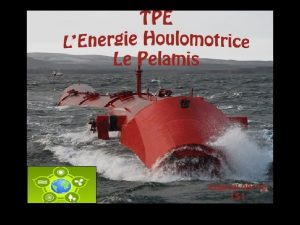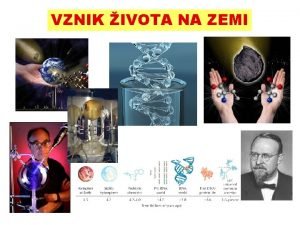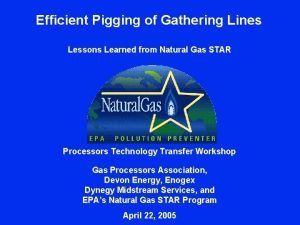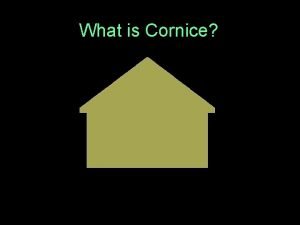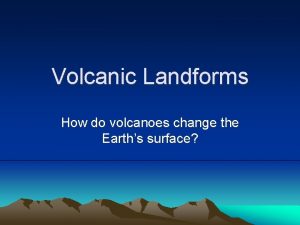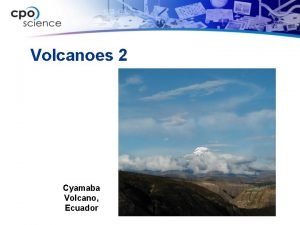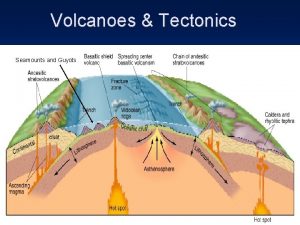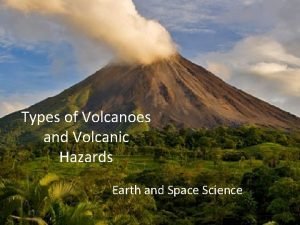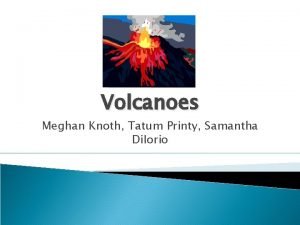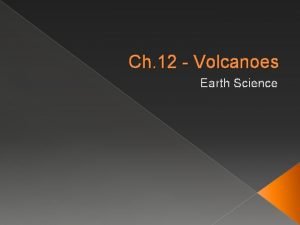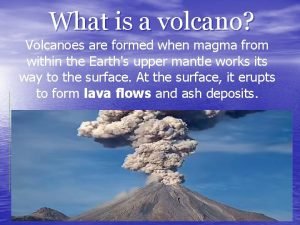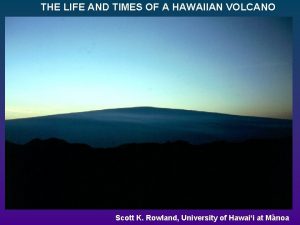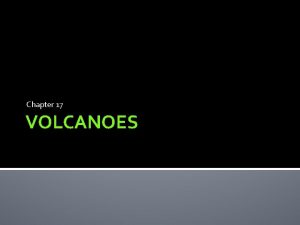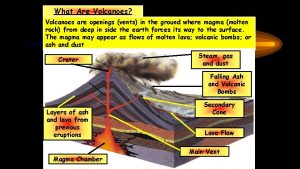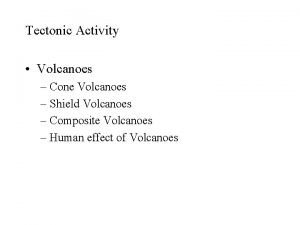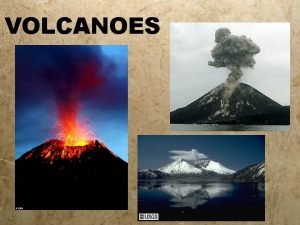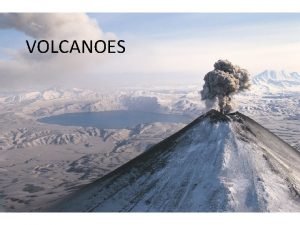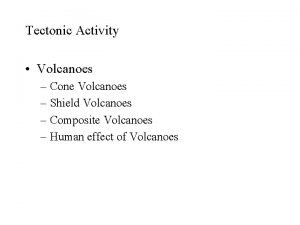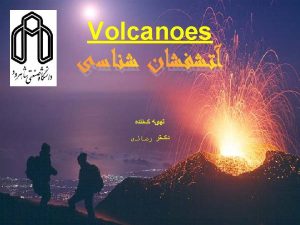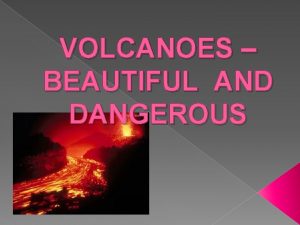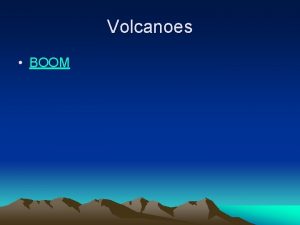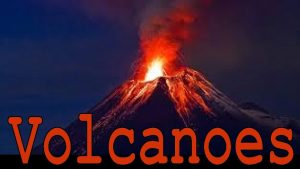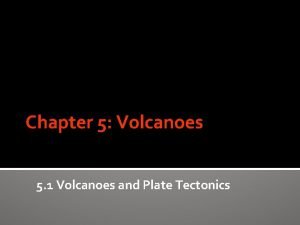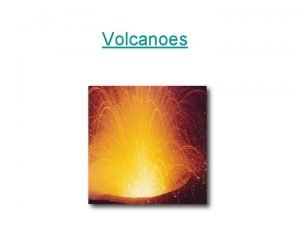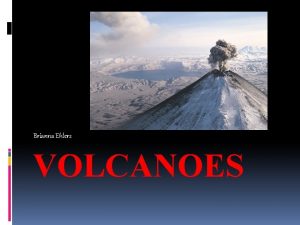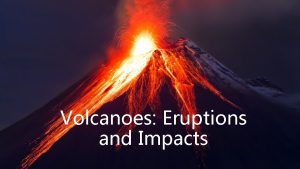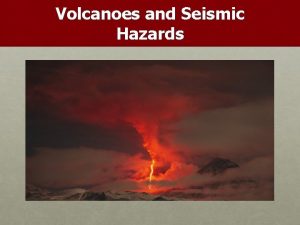Volcanoes What are Volcanoes Volcanoes are vents in


















- Slides: 18

Volcanoes

What are Volcanoes? ● Volcanoes are vents in the Earth’s crust through which melted rock flows onto Earth’s surface. ● Magma is molten, or melted, rock below Earth’s surface. ● Similar to earthquakes, areas with volcanoes are usually near plate boundaries.

How do volcanoes form? ● Volcanic can form large mountains and new crust, and destroy features or buildings at Earth’s surface.

Convergent Boundaries ● Magma is less dense than the surrounding mantle so it rises through cracks in Earth’s surface. ● A combination of thermal energy from below Earth’s surface and fluids from sinking slab melt the mantle.

Divergent Boundaries ● New oceanic crust forms when magma rises to the surface at a divergent plate boundary along a midocean ridge.

Hot Spots ● Scientist hypothesize that hot spots form above plumes of hot mantle material. ● volcanoes form when magma erupts onto Earth’s surface, either along plate boundaries or over a hot spot. https: //www. youtube. com/watch? v=Ah. Sa. E 0 omw 9 o

Where do volcanoes form? ● Most volcanoes form near plate boundaries. ● Volcanoes also occur over hot spots. ● The Ring of Fire surrounds the Pacific Ocean.

Where do volcanoes form? ● The United States Geological Survey (USGS) monitors volcanic activity in the U. S. ● Scientist monitor earthquake activity, changes in the shape of a volcano, gas emissions, and the past eruptive history. ● The more data scientist collect, the better the can predict eruptions.

Types of volcanoes ● Shield volcanoes, composite volcanoes, cinder cones, and super volcanoes. ● The composition of magma and eruptive style contribute to the shape of a volcano. ● Shield and cinder cone volcanoes both erupt lava. Shield volcanoes are large with gentle slopes. Cinder cones are small, steep-sided volcanoes.

Types of Volcanoes ● A caldera is a depression formed when a volcano’s summit collapses or is blown away by explosive activity. https: //www. youtube. com/watch? v=Dn. Bggr. Cdk. N 0

Volcanic Eruptions ● Lava is magma that erupts onto Earth’s surface. ● Volcanic ash consists of tiny particles of rock and glass that erupt into the air. ● The chemistry of magma, such as the amount of water vapor and silica it contains, affects the style of eruption.

Volcanic Eruptions ● The types of gases dissolved in magma are: o water vapor o carbon dioxide o sulfur dioxide

Volcanic Eruptions ● As magma rises to the surface, the pressure decreases, so the gases cannot remain dissolved. The gases begin to escape from the magma. In high-viscosity lavas, the gases cannot escape as easily, which can result in an explosive eruption. http: //www. discovery. com/tv-shows/discoverypresents/videos/understanding-volcanoes-mt-sainthelens. htm

Effects of eruptions There are positive effects and negative effects of volcanic eruptions. https: //www. youtube. com/watch? v=q 0 cvu. Df 1 In k

Effects of eruptions Positive effects ● Volcanoes enrich rock and soils with nutrients. ● Help to regulate the climate Negative effects ● Volcanic ash can affect air quality. ● Lava flows threaten nearby communities ● Thermal energy melts snow and ice and causes mudflows.

Effects of eruptions ● Pyroclastic flows are avalanches of hot gas, ash, and rock.

Predicting Volcanic Eruptions Scientist monitor changes to predict eruptions ● Shape of a volcanoes ● Changes in the shape of the ground a volcano ● gas emissions ● groundwater and surface water near volcanoes

Volcanic Eruptions and Climate Change Explosive volcanoes erupt ash and gas, which reflect sunlight, causing temperatures to decrease, affecting climate. Plants can also be affected when plants don’t get enough sunlight for photosynthesis.
 Mikael ferm
Mikael ferm Les vents
Les vents Ciel, air et vents, plains et monts découverts analyse
Ciel, air et vents, plains et monts découverts analyse Chems sex
Chems sex Bresenham vents
Bresenham vents Escola sant jaume dels domenys
Escola sant jaume dels domenys What is cornice in construction
What is cornice in construction Colt smoke vents
Colt smoke vents Ies veles e vents
Ies veles e vents Nom dels vents a catalunya
Nom dels vents a catalunya Laccolith
Laccolith Cotapoxi
Cotapoxi Three main ways volcanoes are created
Three main ways volcanoes are created What is constructive force
What is constructive force Types of volcanoes
Types of volcanoes Shield volcanoes
Shield volcanoes How are volcanoes formed
How are volcanoes formed Volcano diagram for kids
Volcano diagram for kids A'a hawaiian
A'a hawaiian

